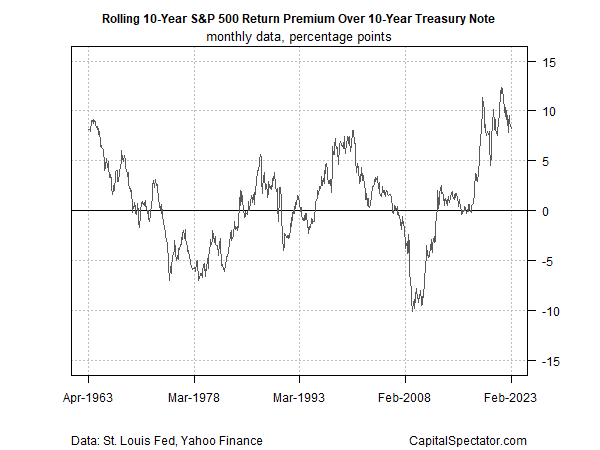The instance for increasing equity appropriations when rates of interest were close to absolutely no was simple. After a year of rate of interest walkings by the, the calculus is a lot more complex.
By some accounts, a desirable tailwind is currently blowing for bonds, specifically for a buy-and-hold technique with Treasuries. Jim Bianco of Bianco Study highlighted the suggestion today by keeping in mind that getting Treasuries of late, as well as taking advantage of greatly greater present returns, provides a chance undetected over the last few years previously.
” You are going to obtain two-thirds of the long-lasting admiration of the securities market without any danger whatsoever,” stated Bianco.
Fair factor, yet choosing exactly how or if to increase weights in bonds– Treasuries specifically– calls for thoughtful evaluation. Given, a at 3.88% (since Feb. 23) is close to the highest degree in greater than a years as well as a globe over the 2020 low of approximately 0.5%. What’s not to such as?
Yet choosing just how much to keep in Treasuries calls for considering greater than returns. It’s additionally a job of considering your time perspective, danger resistance, as well as various other variables that specify to you. It is essential to additionally make some presumptions regarding exactly how equity returns will certainly unravel over an appropriate time perspective vs. the bond maturation you prefer. An excellent location to begin is thinking about exactly how the United States securities market () contrasts on a moving 10-year basis vs. acquiring as well as holding a 10-year Treasury note, which is summed up in the graph listed below for outcomes considering that the very early 1960s.
Moving 10-Year Return: S&P 500 vs 10-Year T-Note
As an estimate of what you would certainly have gained in a 10-year note, I’m making use of the present return for a 10-year Treasury as a return price quote. For instance, presume you got a 10-year note a years earlier when the present return was simply listed below 2%. Purchasing as well as holding that note suggests a 2% return over the succeeding years, as revealed by the last factor at a loss line in the graph above. Comparative, the S&P 500 gained an annualized 10.2% over the tracking years (black line). Heaven line notes the present 10-year Treasury return: 3.88% (Feb. 23), which acts as a trusted projection of anticipated return for a 10-year note for the years in advance.
The essential takeaway: the S&P’s 10-year return differs extensively about the indicated return for acquiring as well as holding a 10-year note. Not a surprise, yet it’s a pointer that when you get a Treasury, as well as how much time you hold it, will certainly cast a lengthy darkness on exactly how the financial investment prices.
For a more clear contrast of exactly how the S&P’s efficiency compares to a buy-and-hold 10-year note setting, the following graph tracks the securities market’s costs over this Treasury safety and security. Plainly, current background has actually been abnormally kind to a hefty allotment in equities.

Moving 10-Year S&P 500 Return Costs Over 10-Year T-Note
Is it prompt to change to a hefty bond (Treasury) allotment? Possibly, yet the solution calls for greater than just contrasting present returns in the bond market, although that’s an excellent location to begin the evaluation.